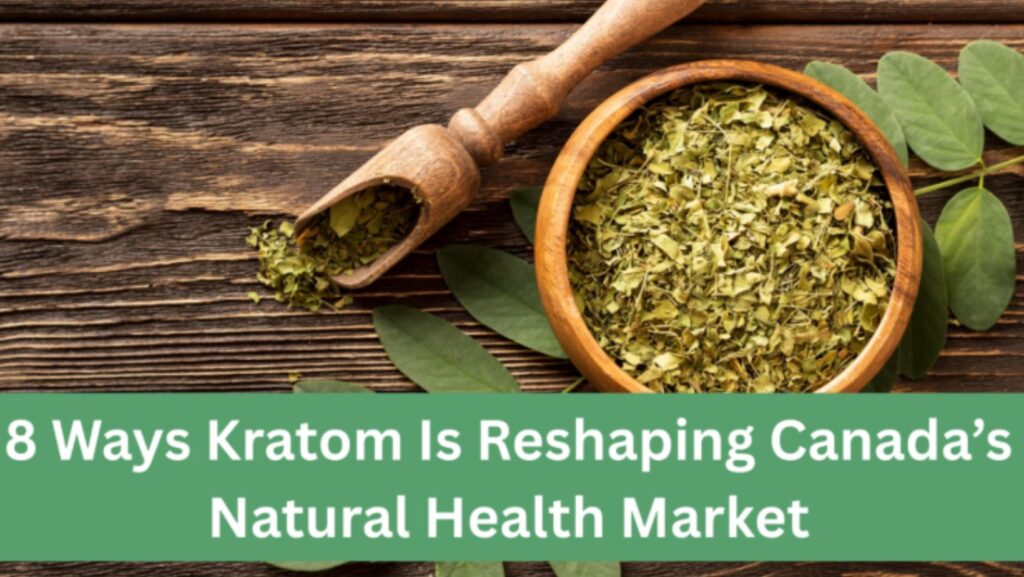
Over the past few years, Canadians have been seeking naturally available remedies to deal with stress, enhance energy levels, and support well-being in general. Conventional supplements such as ginseng, turmeric, or green tea extracts are not new, but they do not necessarily provide the needed outcome.
Simultaneously, pharmaceutical alternatives may be costly, have adverse effects, and cause individuals to be reluctant to use them on a long-term basis. This disparity between the traditional solutions and customer expectations has encouraged individuals to seek new natural products.
Kratom is one of the plants that has received consistent attention.
It originated in Southeast Asia and has found its way into the Canadian natural health market, sparking both fascination and controversy. For some, it could be a possible wellness instrument, whereas for other people, it can be an issue of safety and regulation. Along with that change, kratom is starting to change the perception of natural remedies among Canadians.
This article discusses the eight ways in which kratom is transforming the natural health market in Canada.
1. Expanding Consumer Choice

A constant growth in Canada kratom store number has been at the forefront of the expansion of consumer choices.
These suppliers provide a diversity of wellness tools to Canadians like never before by offering different strains, blends, and product sizes. Kratom is not taking the place of standard herbs, but it is adding an extra dimension to the market.
Such expansion gives people the opportunity to experiment with options that suit their individual requirements, be it focus, rest, or wellness in general.
2. Driving Interest in Plant-Based Alternatives
With the rise of holistic health discussions, there has been increased interest in plant-based remedies, which has led to an increase in the demand for kratom.
Its natural origins have attracted many consumers who have interpreted it as a wider move toward herbal supplements as an alternative to synthetic products. The trend has motivated retailers to expand their product lines and provide services to individuals who appreciate botanical solutions.
The shift to herbal products instead of pharmaceuticals is not only transforming the way Canadians engage in shopping, but is also changing the way they are thinking about long-term health approaches.
3. Raising Awareness About Transparency

Due to the increase in popularity of kratom, customers have become increasingly concerned about the origin of their products. Issues regarding purity, safety and potency have created a tendency to focus on transparency.
Vendors are currently being compelled to present more detailed information about products and, in certain instances, even lab results. This increased attention to responsibility is already spreading shockwaves throughout the natural health market and producing better standards than benefit kratom consumers.
4. Influencing Online Retail Growth
The distribution of kratom in Canada is mainly done through the online platform, and this has enhanced e-commerce growth in the natural health industry. Due to the fact that most physical health stores are still wary of stocking it, the gap has been occupied by digital stores.
This has increased the level of comfort among consumers of the idea of buying natural health products online, thus leading to more acceptance of e-commerce as a reliable medium to buy supplements and herbal remedies.
5. Encouraging Conversations About Regulation
In contrast to well-known supplements, kratom is a gray area in Canadian regulations. Its increasing popularity has raised debates among health workers, policymakers, and consumers on the best way to handle it.
Such discussions are shaping the future of natural health regulations and establishing pressure on more explicit guidelines that would give priority to both consumer safety and access to products.
This may establish new precedents in the way herbal products are tested and accepted in the Canadian market in the long run.
6. Highlighting the Role of Community Feedbacks

The rise of kratom has shown how critical community feedback can be.
With limited clinical studies available, many buyers rely on peer reviews, online forums, and testimonials to guide their decisions. This reliance on collective experience has shifted how people view natural health products, placing greater value on shared insights rather than marketing claims.
Over time, this emphasis on consumer voices is likely to shape trust across the entire herbal supplement industry.
7. Inspiring Product Innovation
As kratom gains momentum, vendors are introducing new formats to meet consumer preferences. Beyond the traditional powders, capsules, extracts, and blends have become common. These innovations make kratom more accessible to different lifestyles, whether someone prefers convenience, precision, or variety.
This wave of product creativity is reflective of a larger trend within Canada’s natural health market, where companies adapt quickly to evolving consumer expectations.
8. Strengthening the Focus on Responsible Use
Perhaps the most important impact of kratom on Canada’s natural health industry is the emphasis on responsible use.
With growing interest comes the need for education, clear dosage guidance, and awareness of sourcing practices. Vendors and community advocates are prioritizing consumer knowledge to ensure safe experiences.
This focus on responsibility is helping to build a culture of informed decision-making, which benefits not only kratom users but also the broader natural health community.
Conclusion
Kratom’s entry into the Canadian natural health market is more than a passing trend. It is reshaping consumer expectations, retail practices, and regulatory conversations.
By expanding choice, driving demand for plant-based alternatives, and underscoring the importance of transparency, it is setting new standards for how natural remedies are approached in Canada. While debates about its role continue, its influence is undeniable.
Kratom is not only shaping how Canadians view herbal supplements today but also guiding the future direction of the natural health industry.












